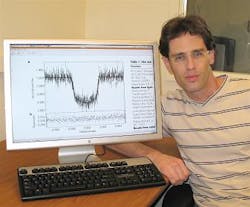Temperate exo-Jupiter discovered; now, how about a habitable exomoon?
Santa Barbara, CA--An exoplanet the size of Jupiter, and in the temperate range around its parent star, has been discovered by a team of scientists from four continents.1
The planet, called CoRoT-9b, was discovered by using the CoRoT space telescope satellite, operated by the French space agency, the Centre National d'Études Spatiales (CNES; Paris, France). The newly discovered planet orbits a star similar to our sun and is located in the constellation Serpens Cauda, 1500 light-years away from earth.
It could be a contender
While not played up by the scientists, this planet--a gas giant with a temperature between 250 K and 430 K (-23 °C and +157 °C)--has the characteristics of the fictional gas giant in the movie Avatar; that gas giant had a moon that not only possessed complex life forms, but also events of great enough interest to spawn a computer-animated story.
At the moment, we do not have the technology to detect such exomoons; scientists have worked hard enough simply to be able to detect exo-Jupiters. However, the Kepler mission (http://kepler.nasa.gov/) may one day allow the human race to detect such exomoons (http://www.astronomynow.com/news/n0909/04exomoon/).
The European-led discovery involved 60 astronomers worldwide. "CoRoT-9b is the first transiting extrasolar planet that is definitely similar to a planet in our solar system, namely Jupiter," said Avi Shporer (see figure), a postdoctoral fellow at the University of California, Santa Barbara, and a member of the team. "What is special about this planet is that it transits a star, and it is a temperate planet. It has great potential for future studies concerning its physical characteristics and atmosphere." The planet is mostly made of hydrogen and helium, but may contain up to 20 Earth masses of heavier elements including rock and water under high pressure.
A transit occurs when a celestial body passes in front of its host star and blocks some of the star's light. This type of eclipse causes a small drop in the apparent brightness of the star and enables the planet's mass, diameter, density, and temperature to be deduced. CoRoT-9b takes 95 Earth days to orbit its star. This is about 10 times longer than that of any planet previously discovered by the transit method.
The CoRoT satellite identified the planet after 150 days of continuous observation in the summer of 2008. The discovery of the planet was verified by ground-based telescopes. Those include the two-meter Las Cumbres Observatory Global Telescope Faulkes Telescope North (FTN), located on Mt. Haleakala on the Hawaiian island of Maui.
The CoRoT space telescope satellite is named for "convection, rotation, and transits." France, Austria, Germany, Spain, Belgium, Brazil, and the European Space Agency (ESA) contributed to the telescope. It was specifically designed to detect transiting exoplanets and carry out seismological studies of stars.
Come on, James
Avatar director James Cameron was not in any way associated with the brilliant scientific team that discovered CoRoT-9b. But he could, if so inclined, do a superb job of publicizing this discovery.
REFERENCE
1.H. J. Deeg et al., Nature 464, p. 384 (18 March 2010) -- doi:10.1038/nature08856

John Wallace | Senior Technical Editor (1998-2022)
John Wallace was with Laser Focus World for nearly 25 years, retiring in late June 2022. He obtained a bachelor's degree in mechanical engineering and physics at Rutgers University and a master's in optical engineering at the University of Rochester. Before becoming an editor, John worked as an engineer at RCA, Exxon, Eastman Kodak, and GCA Corporation.
